Investigating Behavior of Six Methods for Sediment Transport Capacity Estimation of Spatial-Temporal Soil Erosion
Abstract
:1. Introduction
2. Study Area and Data Availability
3. Methodology
3.1. Six Methods for Sediment Transport Capacity Estimation
3.2. Physics-Based Model: GSSHA
3.3. Model Setup and Evaluation
4. Results and Discussion
4.1. Rainfall-Runoff Calibration
4.2. Sediment Transport Evaluation
4.3. Spatial Distribution of Soil Erosion/Deposition
4.4. Effect of Topography on Spatial Distribution
5. Conclusions
Author Contributions
Funding
Institutional Review Board Statement
Informed Consent Statement
Data Availability Statement
Conflicts of Interest
Appendix A
| Event no. | Rating Curve Equation | Discharge-Sediment Loads Equation |
|---|---|---|
| 1 | Q = 24.945 × (H − 2.281)2.448 | Qs = 9 × 10−6 − 5 × Q1.700 |
| 2 | Q = 53.522 × (H − 2.346)2.219 | Qs = 5 × 10−7 − 6 × Q1.932 |
| 3 | Q = 50.403 × (H − 2.367)2.257 | Qs = 28 × 10−7 − 5 × Q1.818 |
| Soil Type | Sand | Silt | Clay | |||||
|---|---|---|---|---|---|---|---|---|
| Very Coarse | Coarse | Medium | Fine | Very Fine | Coarse | Fine | ||
| 2.0–1.0 mm | 1.0–0.5 | 0.5–0.25 | 0.25–0.1 | 0.1–0.05 | 0.05–0.02 | 0.02–0.002 | 0.002–0.0002 | |
| Anryong | 2.7 | 5.8 | 5.2 | 5.7 | 3.1 | 36.2 | 13.2 | 28.2 |
| Chilgog | 6.7 | 9 | 7.4 | 6.9 | 3.8 | 23.2 | 19.4 | 23.6 |
| Deogpyeong | 2.6 | 4.8 | 4.1 | 3.4 | 4.3 | 20 | 25 | 35.9 |
| Deogsan | 7.3 | 9.1 | 11.4 | 16.1 | 7.8 | 10.5 | 22.5 | 15.3 |
| Eungog | 15.5 | 21.7 | 15.3 | 12.5 | 5.8 | 9.5 | 10.1 | 9.8 |
| Gacheon | 6.8 | 14.3 | 19.9 | 19.4 | 9.9 | 10 | 12.8 | 7 |
| Gopyeong | 0.5 | 1.1 | 1.1 | 1.5 | 1.1 | 47.4 | 9 | 38.2 |
| Gwanag | 19.6 | 12.5 | 9.4 | 8.3 | 9.5 | 15 | 16.5 | 9.3 |
| Hamo | 3.4 | 4.4 | 5.4 | 8.7 | 4.5 | 20 | 30.7 | 23 |
| Hoegog | 7.5 | 14.2 | 15.1 | 15.3 | 6.8 | 13.1 | 17.4 | 10.6 |
| Hogye | 4.7 | 8.2 | 5.9 | 1.8 | 10.9 | 21 | 18.1 | 29.4 |
| Hwadong | 1.4 | 2.9 | 1.2 | 0.8 | 1.9 | 30 | 27.9 | 34 |
| Hwangryong | 1.4 | 6 | 20.8 | 45.8 | 11.7 | 3.5 | 8.4 | 2.5 |
| Imgog | 2 | 4.3 | 5.9 | 8.9 | 7 | 21.9 | 23.7 | 26.4 |
| Janggye | 3.7 | 7.3 | 10.4 | 16.7 | 11.3 | 13.4 | 20.1 | 17.1 |
| Jigog | 11.2 | 15.6 | 12.9 | 12.2 | 5.2 | 13.5 | 15.2 | 14.3 |
| Maegog | 9.4 | 20.1 | 16.9 | 12.9 | 11.3 | 9.7 | 13.1 | 6.6 |
| Namgye | 17.7 | 19.4 | 15.7 | 15.9 | 5.2 | 9.2 | 7.7 | 9.1 |
| Odae | 25 | 18.3 | 6.9 | 6.3 | 6.1 | 17.2 | 4.6 | 15.4 |
| Oesan | 5.9 | 7.3 | 4.2 | 4 | 2.4 | 28 | 27.4 | 20.8 |
| Osan | 5 | 11 | 0.1 | 9 | 5.2 | 28.9 | 24.6 | 16.2 |
| Pungcheon | 6.5 | 12.6 | 14.3 | 14 | 6.6 | 15.4 | 14.8 | 15.8 |
| Rcs | 6.7 | 9 | 7.4 | 6.9 | 3.8 | 23.2 | 19.4 | 23.6 |
| Rock outcrop | 0.5 | 1.1 | 1.1 | 1.5 | 1.1 | 47.4 | 9 | 38.2 |
| Sachon | 4.9 | 12.9 | 18.5 | 15.4 | 9.1 | 15.3 | 11.4 | 12.4 |
| Samam | 4.2 | 7.4 | 7.8 | 9 | 6.8 | 24.3 | 22.3 | 18.3 |
| Samgag | 16.4 | 17.3 | 13.1 | 6.9 | 6.9 | 11 | 13.9 | 14.6 |
| Sangju | 13.8 | 22.9 | 21.9 | 12.4 | 5.5 | 7.9 | 6.6 | 9 |
| Seogto | 3.8 | 5.3 | 3.7 | 3.4 | 1.9 | 31.6 | 23.4 | 27 |
| Seongin | 4.4 | 9.3 | 11.5 | 6.8 | 3.5 | 25.5 | 17 | 22.1 |
| Songsan | 9.8 | 18.6 | 15.1 | 12.3 | 5 | 10.6 | 11.1 | 17.6 |
| Suam | 7.5 | 10.6 | 16.8 | 22.8 | 14.9 | 10 | 10.6 | 6.9 |
| Ugog | 3.6 | 3.3 | 1.5 | 0.3 | 5.5 | 25 | 30 | 30.9 |
| Water | 2 | 4.3 | 5.9 | 8.9 | 7 | 21.9 | 23.7 | 26.4 |
| Weolgog | 15.5 | 21.7 | 15.3 | 12.5 | 5.8 | 9.5 | 10.1 | 9.8 |
| Yecheon | 15.9 | 16.6 | 10.8 | 10.3 | 5.8 | 14.5 | 11.8 | 14.5 |
| Yesan | 9.7 | 17.4 | 15.3 | 13 | 5.4 | 8.8 | 12.3 | 18 |
| Yonggye | 5.7 | 7.9 | 6.8 | 6.5 | 3.9 | 22 | 21.7 | 25.6 |
References
- Foster, G.G. The Use of Bridging Systems to Increase Genetic Variability in Compound Chromosome Strains for Genetic Control of Lucilia Cuprina (Wiedemann). Theor. Appl. Genet. 1982, 63, 295–305. [Google Scholar] [CrossRef] [PubMed]
- Li, G.; Abrahams, A.D. Controls of Sediment Transport Capacity in Laminar Interrill Flow on Stone-Covered Surfaces. Water Resour. Res. 1999, 35, 305–310. [Google Scholar] [CrossRef]
- Mu, H.; Yu, X.; Fu, S.; Yu, B.; Liu, Y.; Zhang, G. Effect of Stem Basal Cover on the Sediment Transport Capacity of Overland Flows. Geoderma 2019, 337, 384–393. [Google Scholar] [CrossRef]
- Lindström, G.; Pers, C.; Rosberg, J.; Strömqvist, J.; Arheimer, B. Development and Testing of the HYPE (Hydrological Predictions for the Environment) Water Quality Model for Different Spatial Scales. Hydrol. Res. 2010, 41, 295–319. [Google Scholar] [CrossRef]
- Morgan, R.P.C.; Quinton, J.N.; Smith, R.E.; Govers, G.; Poesen, J.W.A.; Auerswald, K.; Chisci, G.; Torri, D.; Styczen, M.E. The European Soil Erosion Model (EUROSEM): A Dynamic Approach for Predicting Sediment Transport from Fields and Small Catchments. Earth Surf. Process. Landf. 1998, 23, 527–544. [Google Scholar] [CrossRef]
- Von Werner, M. Erosion-3D: User Manual, Version. 3.1.1 2006; Geognostics: Berlin, Germany, 2006. [Google Scholar]
- Ewen, J.; Parkin, G.; O’Connell, P.E. SHETRAN: Distributed River Basin Flow and Transport Modeling System. J. Hydrol. Eng. 2000, 5, 250–258. [Google Scholar] [CrossRef] [Green Version]
- USDA-ARS. Revised Universal Soil Loss Equation Version 2 (RUSLE2); (For the Model with Release Date of 20 May 2008); Agricultural Research Service: Washington, DC, USA, 2013. [Google Scholar]
- APIP; Lee, G.; Yu, W.; Jung, K. Catchment-Scale Soil Erosion and Sediment Yield Simulation Using a Spatially Distributed Erosion Model. Env. Earth Sci. 2013, 70, 33–47. [Google Scholar] [CrossRef]
- Wang, S.; Flanagan, D.C.; Engel, B.A. Estimating Sediment Transport Capacity for Overland Flow. J. Hydrol. 2019, 578, 123985. [Google Scholar] [CrossRef]
- Ali, M.; Seeger, M.; Sterk, G.; Moore, D. A Unit Stream Power Based Sediment Transport Function for Overland Flow. Catena 2013, 101, 197–204. [Google Scholar] [CrossRef]
- Ali, M.; Sterk, G.; Seeger, M.; Boersema, M.; Peters, P. Effect of Hydraulic Parameters on Sediment Transport Capacity in Overland Flow over Erodible Beds. Hydrol. Earth Syst. Sci. 2012, 16, 591–601. [Google Scholar] [CrossRef] [Green Version]
- Zhang, G.; Liu, Y.; Han, Y.; Zhang, X.C. Sediment Transport and Soil Detachment on Steep Slopes: I. Transport Capacity Estimation. Soil Sci. Soc. Am. J. 2009, 73, 1291–1297. [Google Scholar] [CrossRef]
- Abrahams, A.D.; Li, G.; Krishnan, C.; Atkinson, J.F. A Sediment Transport Equation for Interrill Overland Flow on Rough Surfaces. Earth Surf. Process. Landf. 2001, 26, 1443–1459. [Google Scholar] [CrossRef]
- Wang, Z.; Yang, X.; Liu, J.; Yuan, Y. Sediment Transport Capacity and Its Response to Hydraulic Parameters in Experimental Rill Flow on Steep Slope. J. Soil Water Conserv. 2015, 70, 36–44. [Google Scholar] [CrossRef] [Green Version]
- Prosser, I.P.; Rustomji, P. Sediment Transport Capacity Relations for Overland Flow. Prog. Phys. Geogr. Earth Environ. 2000, 24, 179–193. [Google Scholar] [CrossRef]
- Everaert, W. Empirical Relations for the Sediment Transport Capacity of Interrill Flow. Earth Surf. Process. Landf. 1991, 16, 513–532. [Google Scholar] [CrossRef]
- Guy, B.T.; Dickenson, W.T.; Sohrabi, T.M.; Rudra, R.P. Development of an Empirical Model for Calculating Sediment-Transport Capacity in Shallow Overland Flows: Model Calibration. Biosyst. Eng. 2009, 103, 245–255. [Google Scholar] [CrossRef]
- Guy, B.T.; Rudra, R.P.; Dickenson, W.T.; Sohrabi, T.M. Empirical Model for Calculating Sediment-Transport Capacity in Shallow Overland Flows: Model Development. Biosyst. Eng. 2009, 103, 105–115. [Google Scholar] [CrossRef]
- Zhang, G.-H.; Wang, L.-L.; Tang, K.-M.; Luo, R.-T.; Zhang, X.C. Effects of Sediment Size on Transport Capacity of Overland Flow on Steep Slopes. Hydrol. Sci. J. 2011, 56, 1289–1299. [Google Scholar] [CrossRef]
- Ni, S.; Feng, S.; Zhang, D.; Wang, J.; Cai, C. Sediment Transport Capacity in Erodible Beds with Reconstituted Soils of Different Textures. Catena 2019, 183, 104197. [Google Scholar] [CrossRef]
- Yu, B.; Zhang, G.; Fu, X. Transport Capacity of Overland Flow with High Sediment Concentration. J. Hydrol. Eng. 2015, 20, C4014001. [Google Scholar] [CrossRef] [Green Version]
- Zhang, G.H.; Wang, L.L.; Li, G.; Tang, K.M.; Cao, Y. Relationship between Sediment Particle Size and Transport Coefficient on Steep Slopes. Trans. ASABE 2011, 54, 869–874. [Google Scholar] [CrossRef]
- Zhan, Z.; Jiang, F.; Chen, P.; Gao, P.; Lin, J.; Ge, H.; Wang, M.K.; Huang, Y. Effect of Gravel Content on the Sediment Transport Capacity of Overland Flow. Catena 2020, 188, 104447. [Google Scholar] [CrossRef]
- Zhang, P.; Yao, W.; Liu, G.; Xiao, P.; Sun, W. Experimental Study of Sediment Transport Processes and Size Selectivity of Eroded Sediment on Steep Pisha Sandstone Slopes. Geomorphology 2020, 363, 107211. [Google Scholar] [CrossRef]
- Gabet, E.J.; Sternberg, P. The Effects of Vegetative Ash on Infiltration Capacity, Sediment Transport, and the Generation of Progressively Bulked Debris Flows. Geomorphology 2008, 101, 666–673. [Google Scholar] [CrossRef]
- Pan, C.; Ma, L.; Shangguan, Z. Effectiveness of Grass Strips in Trapping Suspended Sediments from Runoff. Earth Surf. Process. Landf. 2010, 35, 1006–1013. [Google Scholar] [CrossRef]
- Englelund, F.; Hansen, E. A Monograph on Sediment Transport in Alluvial Streams; Teknisk Forlag: Copenhagen, Denmark, 1967; p. 65. [Google Scholar]
- Yalin, M.S. An Expression for Bed-Load Transportation. J. Hydraul. Div. 1963, 89, 221–250. [Google Scholar] [CrossRef]
- Smart, G.M. Sediment Transport Formula for Steep Channels. J. Hydraul. Eng. 1984, 110, 267–276. [Google Scholar] [CrossRef]
- Seng Low, H. Effect of Sediment Density on Bed-Load Transport. J. Hydraul. Eng. 1989, 115, 124–138. [Google Scholar] [CrossRef]
- Hessel, R.; Jetten, V. Suitability of Transport Equations in Modelling Soil Erosion for a Small Loess Plateau Catchment. Eng. Geol. 2007, 91, 56–71. [Google Scholar] [CrossRef]
- Kilinc, M.; Richardson, E.V. Mechanics of Soil Erosion From Overland Flow Generated; Colorado State University: Fort Colins, CO, USA, 1973; p. 61. [Google Scholar]
- Guy, B.T.; Dickinson, W.T.; Rudra, R.P. Evaluation of Fluvial Sediment Transport Equations for Overland Flow. Trans. ASAE 1992, 35, 545–555. [Google Scholar] [CrossRef]
- Yang, C.T. Unit Stream Power and Sediment Transport. J. Hydraul. Div. 1972, 98, 1805–1826. [Google Scholar] [CrossRef]
- Govers, G. Empirical Relationships on the Transporting Capacity of Overland Flow. In Transport and Deposition Processes (Proceedings of the Jerusalem Workshop, March–April 1987); IAHS Press: Wallingford, UK, 1990; Volume 189, pp. 45–63. [Google Scholar]
- Downer, C.W.; Pradhan, N.R.; Ogden, F.L.; Byrd, A.R. Testing the Effects of Detachment Limits and Transport Capacity Formulation on Sediment Runoff Predictions Using the U.S. Army Corps of Engineers GSSHA Model. J. Hydrol. Eng. 2015, 20, 04014082. [Google Scholar] [CrossRef]
- Sith, R.; Nadaoka, K. Comparison of SWAT and GSSHA for High Time Resolution Prediction of Stream Flow and Sediment Concentration in a Small Agricultural Watershed. Hydrology 2017, 4, 27. [Google Scholar] [CrossRef] [Green Version]
- Ogden, F.L. Evidence of Equilibrium Peak Runoff Rates in Steep Tropical Terrain on the Island of Dominica during Tropical Storm Erika, 27 August 2015. J. Hydrol. 2016, 542, 35–46. [Google Scholar] [CrossRef] [Green Version]
- Pradhan, N.R.; Loney, D. An Analysis of the Unit Hydrograph Peaking Factor: A Case Study in Goose Creek Watershed, Virginia. J. Hydrol. Reg. Stud. 2018, 15, 31–48. [Google Scholar] [CrossRef]
- Saha, G.C.; Li, J.; Thring, R.W.; Hirshfield, F.; Paul, S.S. Temporal Dynamics of Groundwater-Surface Water Interaction under the Effects of Climate Change: A Case Study in the Kiskatinaw River Watershed, Canada. J. Hydrol. 2017, 551, 440–452. [Google Scholar] [CrossRef]
- Hur, J.; Jung, N.-C.; Shin, J.-K. Spectroscopic Distribution of Dissolved Organic Matter in a Dam Reservoir Impacted by Turbid Storm Runoff. Environ. Monit Assess 2007, 133, 53–67. [Google Scholar] [CrossRef]
- Hong, S.Y.; Zhang, Y.-S.; Hyun, B.-K.; Sonn, Y.-K.; Kim, Y.-H.; Jung, S.-J.; Park, C.-W.; Song, K.-C.; Jang, B.-C.; Choe, E.-Y.; et al. An Introduction of Korean Soil Information System. Korean J. Soil Sci. Fertil. 2009, 42, 21–28. [Google Scholar]
- USDA. Soil Taxonomy: A Basic System of Soil Classification for Making and Interpreting Soil Surveys; USDA: Washington, DC, USA, 1999. [Google Scholar]
- Sastre, B.; Barbero-Sierra, C.; Bienes, R.; Marques, M.J.; García-Díaz, A. Soil Loss in an Olive Grove in Central Spain under Cover Crops and Tillage Treatments, and Farmer Perceptions. J Soils Sediments 2017, 17, 873–888. [Google Scholar] [CrossRef]
- K-Water. Hydrological Investigation Report of Yongdam Dam Basin; Korean Water and Wastewater Association: Seoul, Korea, 2002. [Google Scholar]
- K-Water. Hydrological Investigation Report of Yongdam Dam Basin; Korean Water and Wastewater Association: Seoul, Korea, 2003. [Google Scholar]
- K-Water. Hydrological Investigation Report of Yongdam Dam Basin; Korean Water and Wastewater Association: Seoul, Korea, 2007. [Google Scholar]
- Julien, P.Y. Erosion and Sedimentation; Cambridge University Press: Cambridge, UK, 1995. [Google Scholar]
- Ogden, F.; Heilig, A. Two-Dimensional Watershed-Scale Erosion Modeling With CASC2D. In Landscape Erosion and Evolution Modeling; Harmon, R.S., Doe, W.W., Eds.; Springer US: Boston, MA, USA, 2001; pp. 277–320. ISBN 978-1-4613-5139-9. [Google Scholar]
- Downer, C.W.; Ogden, F.L. GSSHA: Model To Simulate Diverse Stream Flow Producing Processes. J. Hydrol. Eng. 2004, 9, 161–174. [Google Scholar] [CrossRef]
- The Complete All-in-one Watershed Solution. Available online: https://www.aquaveo.com/software/wms-watershed-modeling-system-introduction (accessed on 8 July 2021).
- Wicks, J.M.; Bathurst, J.C. SHESED: A Physically Based, Distributed Erosion and Sediment Yield Component for the SHE Hydrological Modelling System. J. Hydrol. 1996, 175, 213–238. [Google Scholar] [CrossRef]
- Capra, A.; Porto, P.; Scicolone, B. Relationships between Rainfall Characteristics and Ephemeral Gully Erosion in a Cultivated Catchment in Sicily (Italy). Soil Tillage Res. 2009, 105, 77–87. [Google Scholar] [CrossRef]
- ESRI. ESRI Data and Maps for ArcGIS; Environmental Systems Research Institute: Redlands, CA, USA, 2021. [Google Scholar]
- Lee, G.; Tachikawa, Y.; Takara, K. Interaction between Topographic and Process Parameters Due to the Spatial Resolution of DEMs in Distributed Rainfall-Runoff Modeling. J. Hydrol. Eng. 2009, 14, 1059–1069. [Google Scholar] [CrossRef]
- Duan, Q.Y.; Gupta, V.K.; Sorooshian, S. Shuffled Complex Evolution Approach for Effective and Efficient Global Minimization. J. Optim. Theory Appl. 1993, 76, 501–521. [Google Scholar] [CrossRef]
- Downer, C.W.; Ogden, F.L. Gridded Surface Subsurface Hydrologic Analysis (GSSHA) User’s Manual; U.S. Army Corps of Engineers: Washington, DC, USA, 2006. [Google Scholar]
- Gupta, H.V.; Sorooshian, S.; Yapo, P.O. Status of Automatic Calibration for Hydrologic Models: Comparison with Multilevel Expert Calibration. J. Hydrol. Eng. 1999, 4, 135–143. [Google Scholar] [CrossRef]
- Du, J.; Xie, S.; Xu, Y.; Xu, C.; Singh, V.P. Development and Testing of a Simple Physically-Based Distributed Rainfall-Runoff Model for Storm Runoff Simulation in Humid Forested Basins. J. Hydrol. 2007, 336, 334–346. [Google Scholar] [CrossRef]
- Johnson, B.E.; Julien, P.Y.; Molnar, D.K.; Watson, C.C. The two-dimensional upland erosion model CASC2D-SED. J. Am. Water Resour. Assoc. 2000, 36, 31–42. [Google Scholar] [CrossRef]
- Lei, T.W.; Zhang, Q.; Zhao, J.; Tang, Z. A Laboratory Study of Sediment Transport Capacity in the Dynamic Process of Rill Erosion. Trans. Am. Soc. Agric. Eng. 2001, 44, 1537–1542. [Google Scholar]
- Xiao, H.; Liu, G.; Liu, P.; Zheng, F.; Zhang, J.; Hu, F. Sediment Transport Capacity of Concentrated Flows on Steep Loessial Slope with Erodible Beds. Sci. Rep. 2017, 7, 1–9. [Google Scholar] [CrossRef] [PubMed]
- Zhang, F.B.; Yang, M.Y.; Li, B.B.; Li, Z.B.; Shi, W.Y. Effects of Slope Gradient on Hydro-Erosional Processes on an Aeolian Sand-Covered Loess Slope under Simulated Rainfall. J. Hydrol. 2017, 553, 447–456. [Google Scholar] [CrossRef]
- Lu, J.Y.; Cassol, E.A.; Moldenhauer, W.C. Sediment Transport Relationships for Sand and Silt Loam Soils. Trans. ASAE 1989, 32, 1923. [Google Scholar] [CrossRef]
- Alonso, C.V.; Neibling, W.H.; Foster, G.R. Estimating Sediment Transport Capacity in Watershed Modeling. Trans. ASAE 1981, 24, 1211–1220. [Google Scholar] [CrossRef]
- Chen, C.-N.; Tfwala, S.S.; Tsai, C.-H. Climate Change Impacts on Soil Erosion and Sediment Yield in a Watershed. Water 2020, 12, 2247. [Google Scholar] [CrossRef]
- Routschek, A.; Schmidt, J.; Kreienkamp, F. Impact of Climate Change on Soil Erosion—A High-Resolution Projection on Catchment Scale until 2100 in Saxony/Germany. Catena 2014, 121, 99–109. [Google Scholar] [CrossRef]
- Yu, W.; Lee, G.; Kim, Y.; Jung, K. Watershed-Based PMF and Sediment-Runoff Estimation Using Distributed Hydrological Model. J. Korean Soc. Agric. Eng. 2018, 60, 1–11. [Google Scholar]
- Li, G.; Wan, L.; Cui, M.; Wu, B.; Zhou, J. Influence of Canopy Interception and Rainfall Kinetic Energy on Soil Erosion under Forests. Forests 2019, 10, 509. [Google Scholar] [CrossRef] [Green Version]
- Wu, L.; Peng, M.; Qiao, S.; Ma, X. Effects of Rainfall Intensity and Slope Gradient on Runoff and Sediment Yield Characteristics of Bare Loess Soil. Environ. Sci. Pollut. Res. 2018, 25, 3480–3487. [Google Scholar] [CrossRef] [PubMed]
- Fox, D.M.; Bryan, R.B. The Relationship of Soil Loss by Interrill Erosion to Slope Gradient. Catena 2000, 38, 211–222. [Google Scholar] [CrossRef]
- Busacca, A.J.; Cook, C.A.; Mulla, D.J. Comparing Landscape-Scale Estimation of Soil Erosion in the Palouse Using Cs-137 and RUSLE. J. Soil Water Conserv. 1993, 48, 361–367. [Google Scholar]
- Zhu, Y.; Wang, D.; Wang, X.; Li, W.; Shi, P. Aggregate-Associated Soil Organic Carbon Dynamics as Affected by Erosion and Deposition along Contrasting Hillslopes in the Chinese Corn Belt. Catena 2021, 199, 105106. [Google Scholar] [CrossRef]
- Walling, D.E.; Webb, B.W. The Reliability of Rating Curve Estimates of Suspended Sediment Yield: Some Further Comments. In Proceedings of the Symposium on Sediment Budgets, Porto Alegre, Brazil, 11–15 December 1988. [Google Scholar]
- Zehe, E.; Becker, R.; Bárdossy, A.; Plate, E. Uncertainty of Simulated Catchment Runoff Response in the Presence of Threshold Processes: Role of Initial Soil Moisture and Precipitation. J. Hydrol. 2005, 1–4, 183–202. [Google Scholar] [CrossRef]
- Ahmadi, S.H.; Amin, S.; Reza Keshavarzi, A.; Mirzamostafa, N. Simulating Watershed Outlet Sediment Concentration Using the ANSWERS Model by Applying Two Sediment Transport Capacity Equations. Biosyst. Eng. 2006, 94, 615–626. [Google Scholar] [CrossRef]
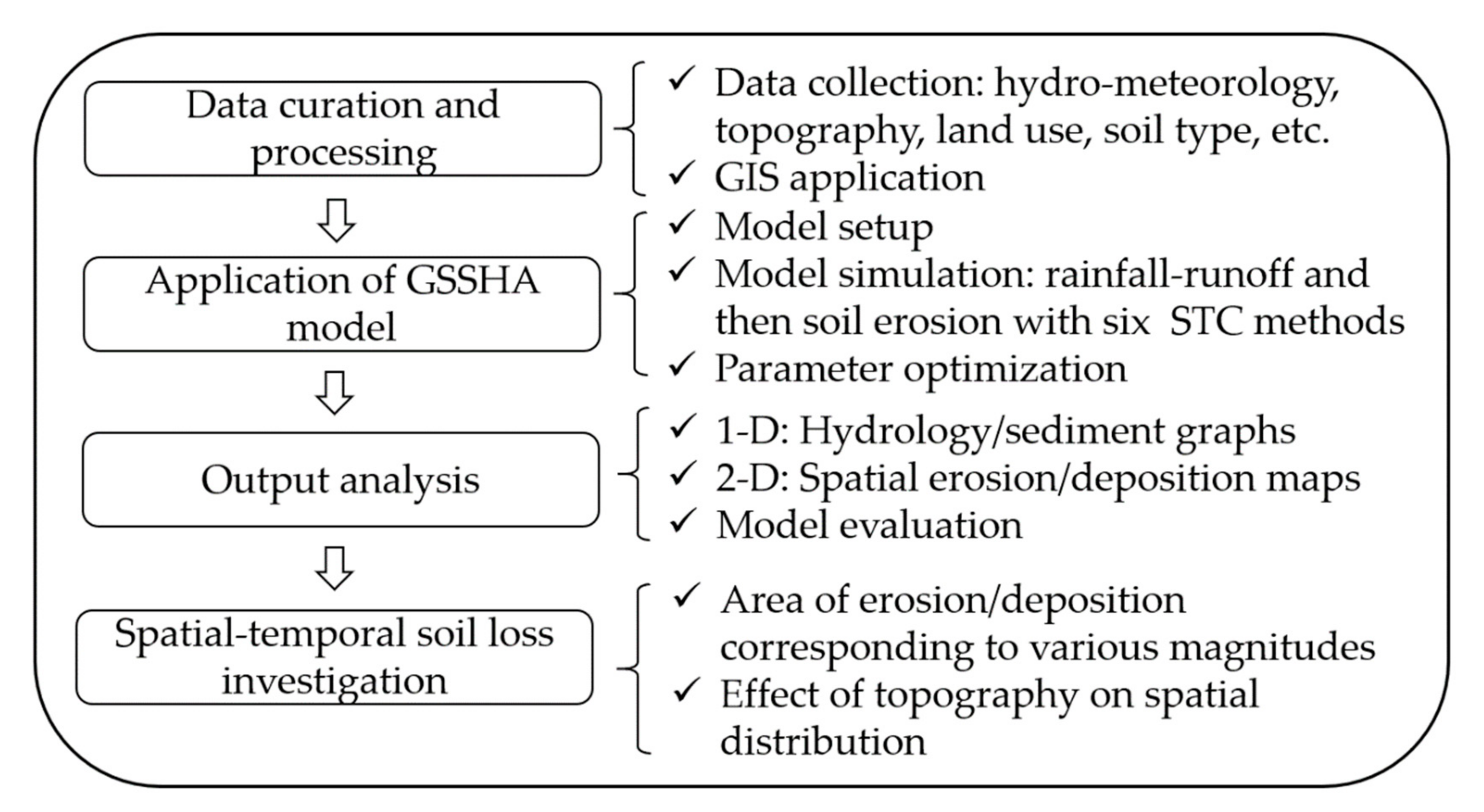
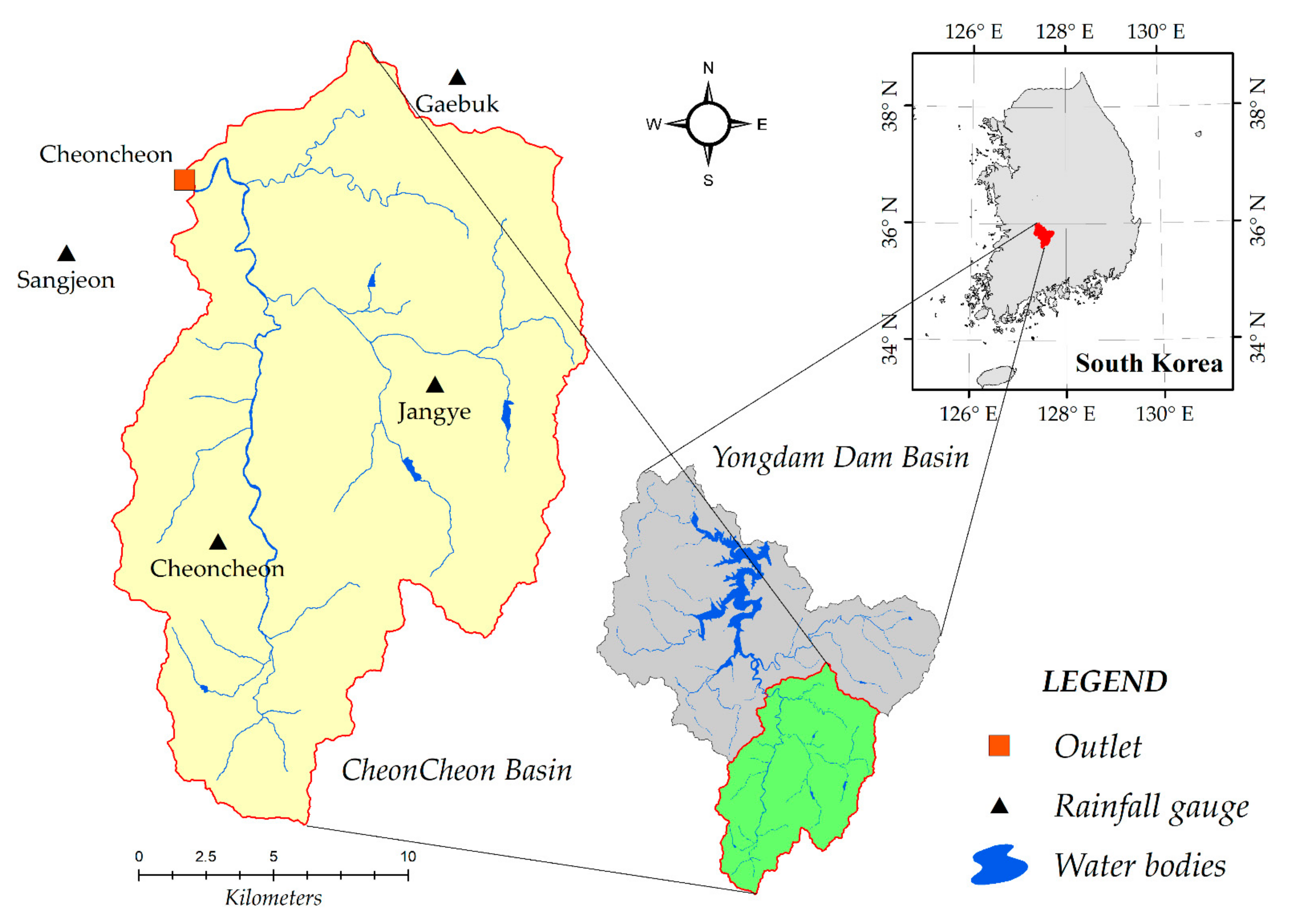
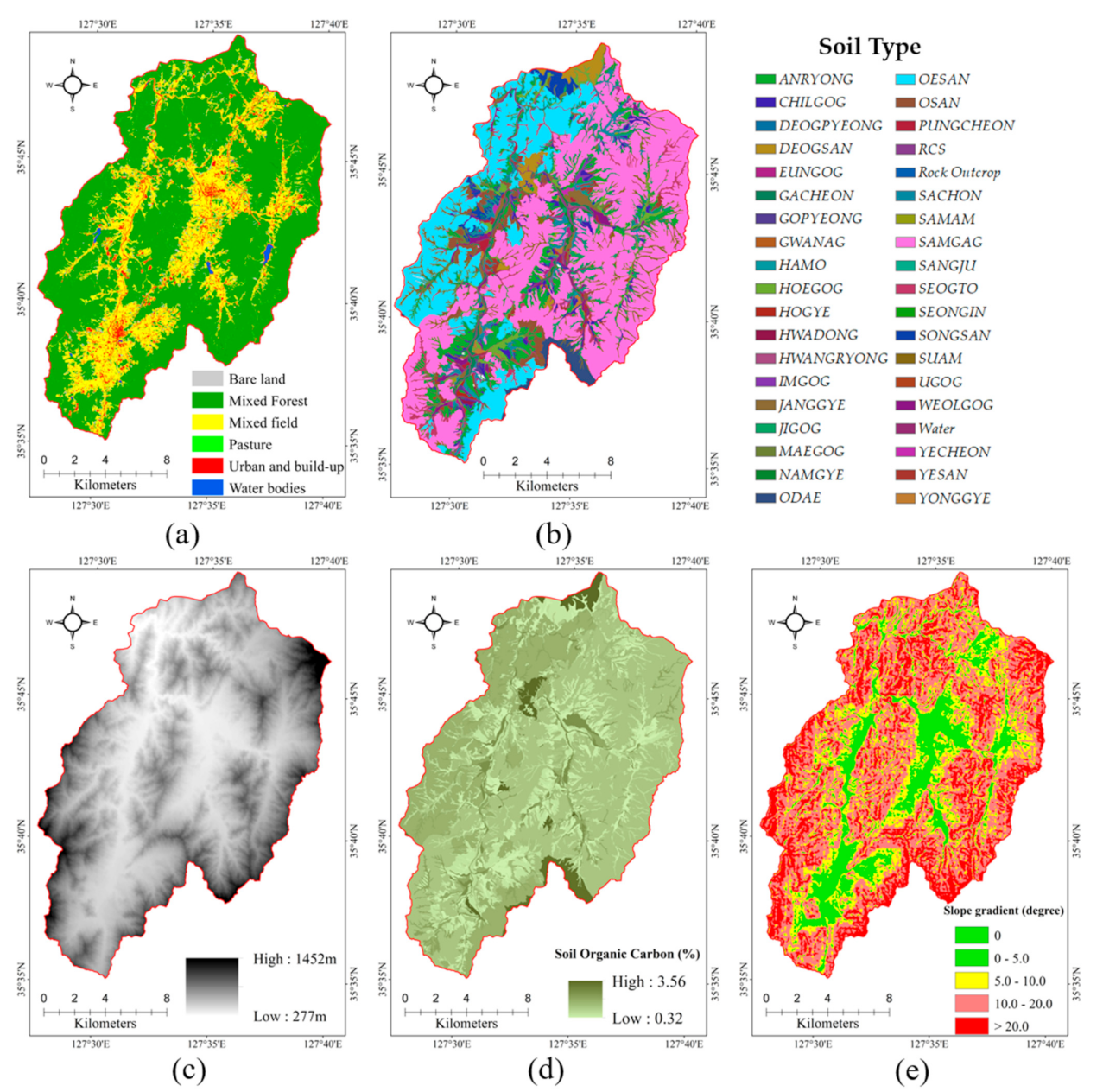
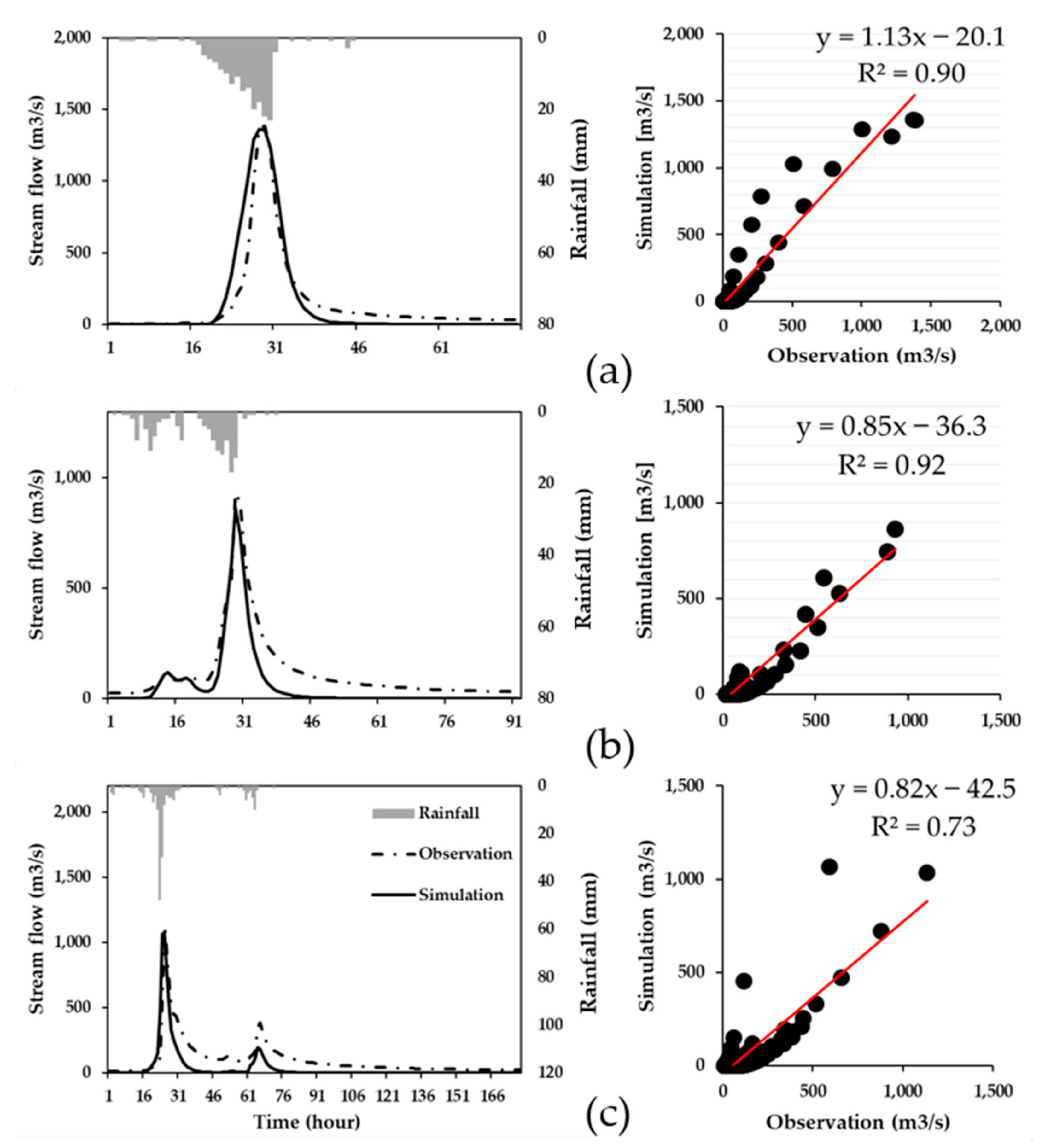
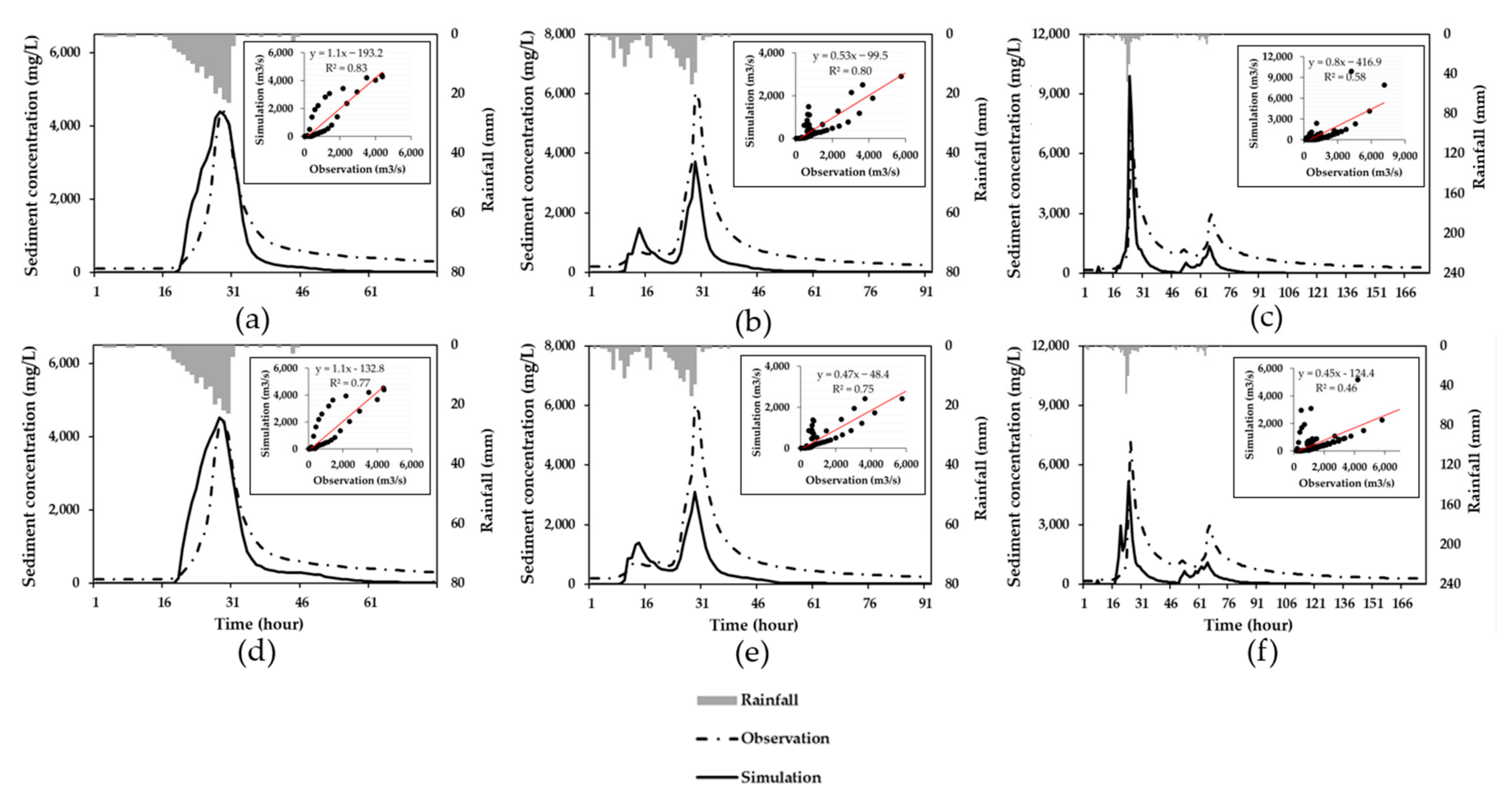
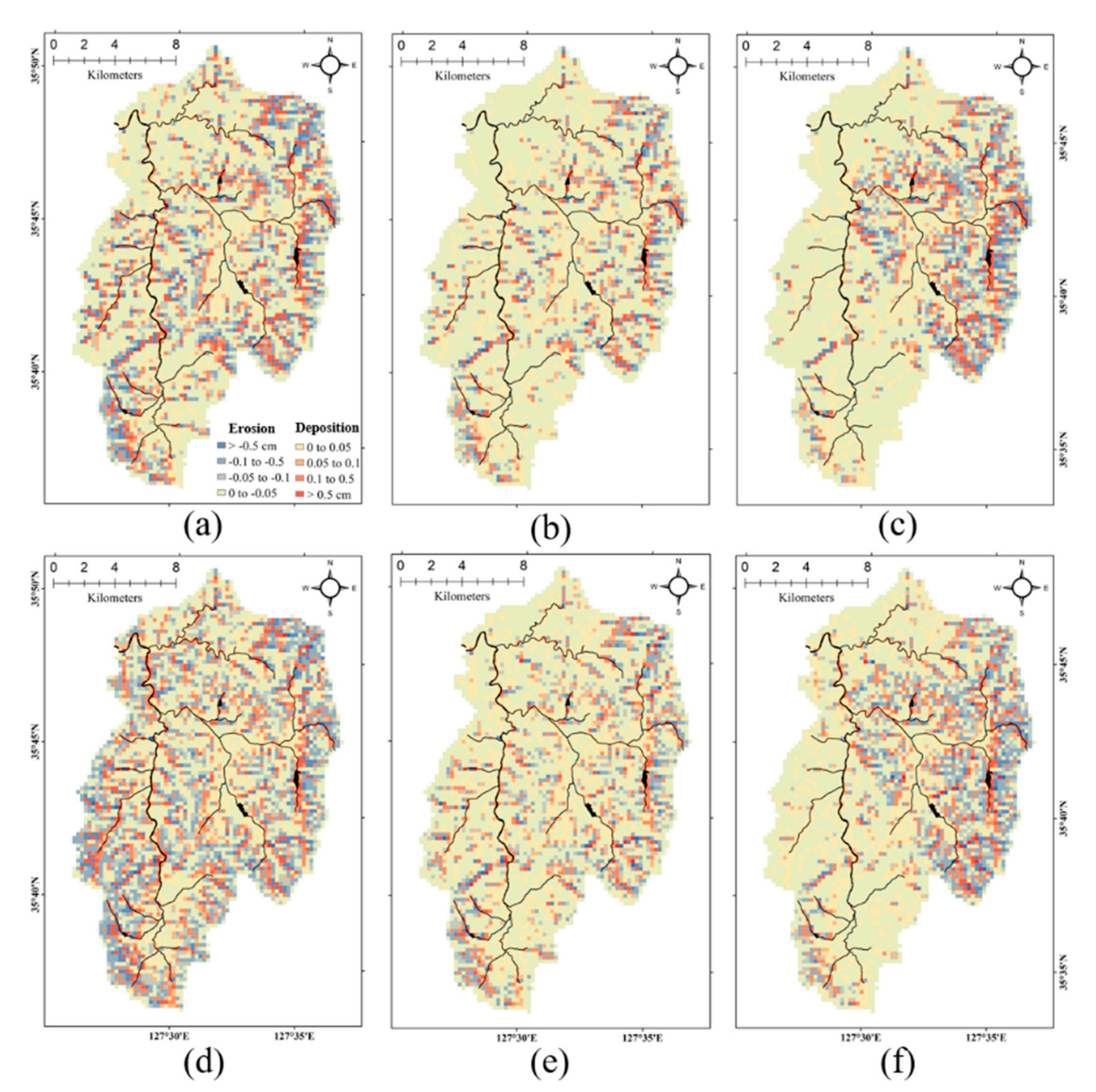
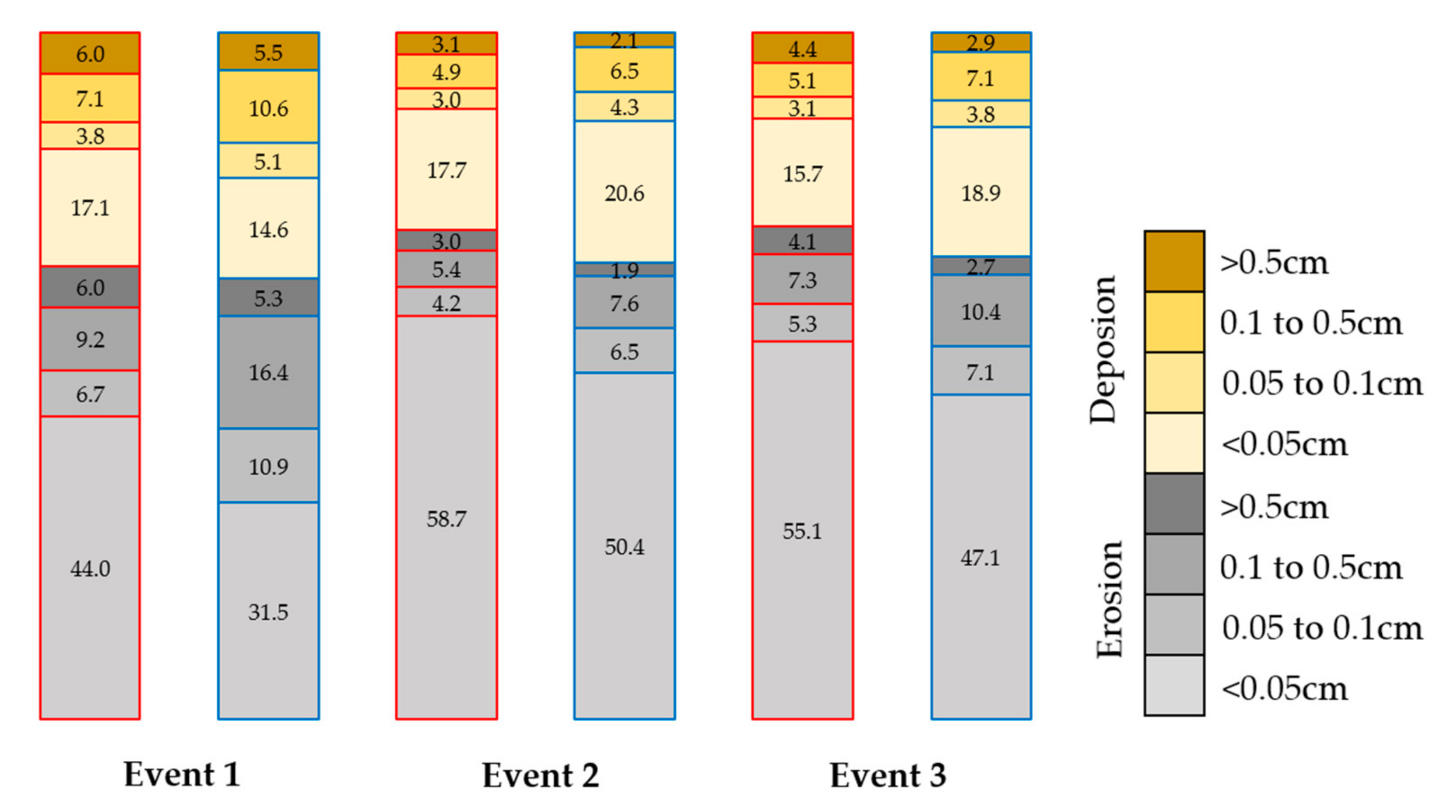
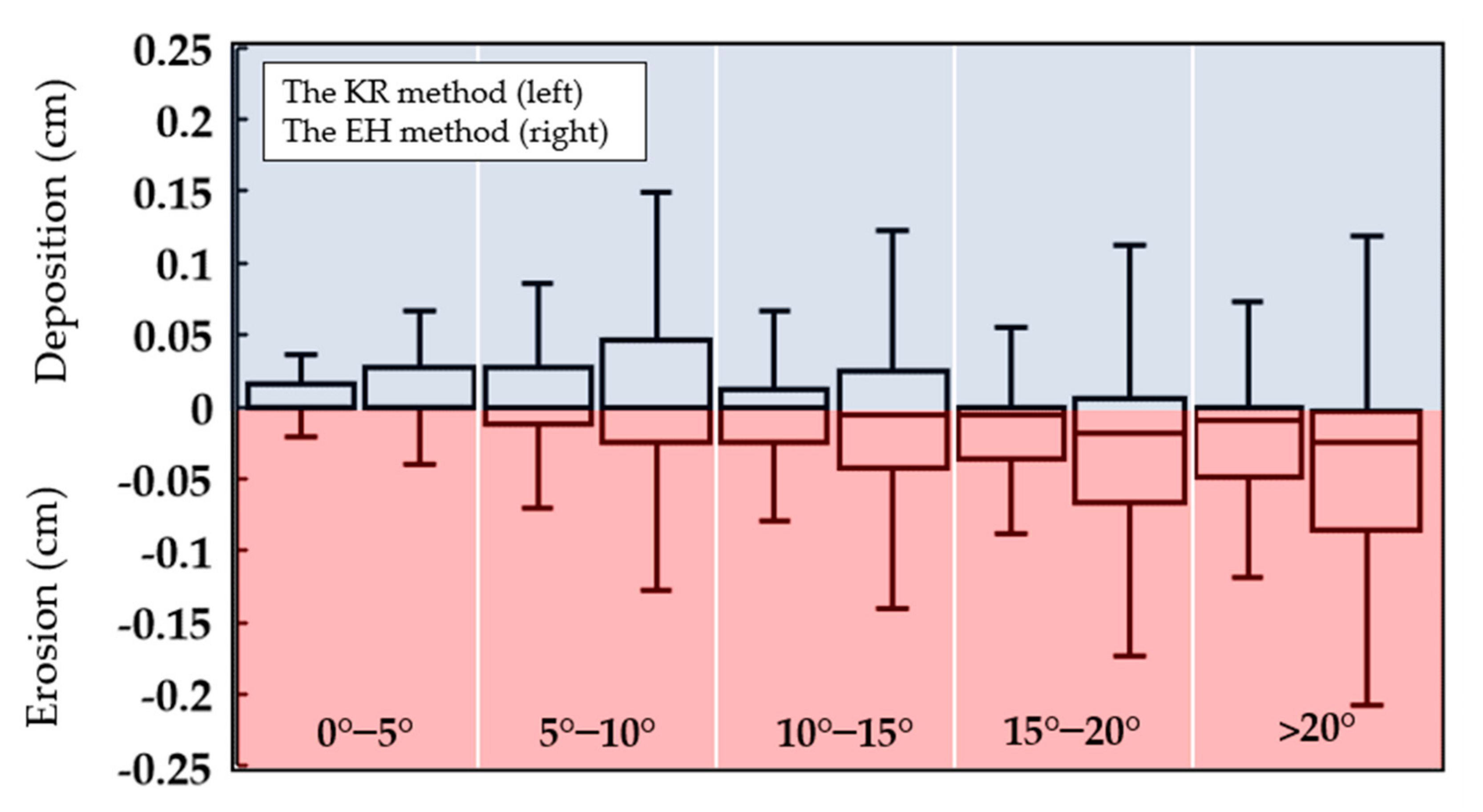
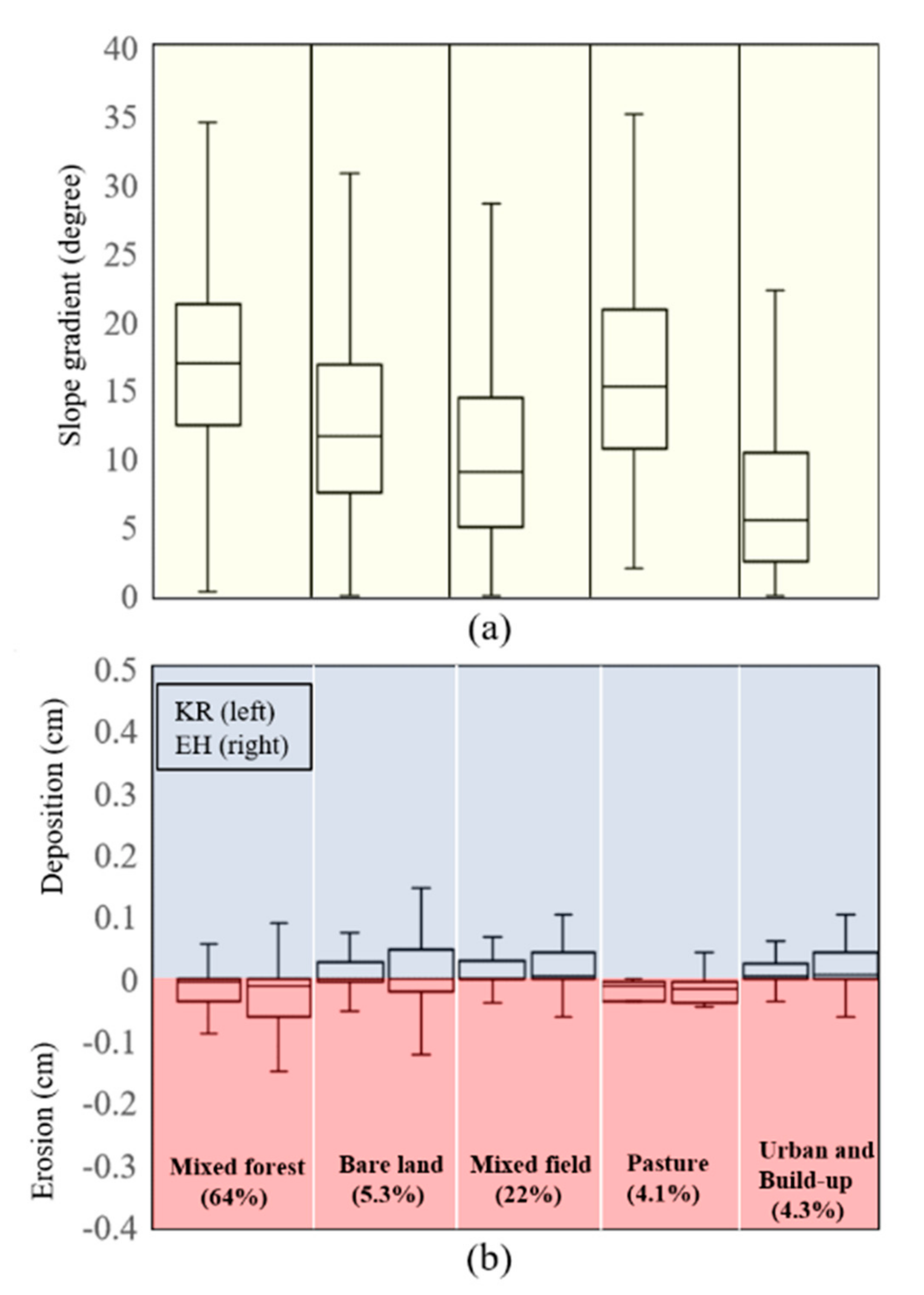
| Description | Particle Diameter (mm) | Particle Size Distribution (%) |
|---|---|---|
| Very coarse sand | 1.45 | Table A2 |
| Coarse sand | 0.65 | |
| Medium sand | 0.37 | |
| Fine sand | 0.17 | |
| Very fine sand | 0.08 | |
| Coarse silt | 0.03 | |
| Fine silt | 0.011 | |
| Clay | 0.003 |
| Event Number | Total Duration (Hour) | Total Rainfall (mm) | Peak Rainfall (mm) | Number of Peaks | Name of Events | Description |
|---|---|---|---|---|---|---|
| 1 | 75 | 194.8 | 27 | 1 | Rusa | Calibration |
| 2 | 92 | 133.9 | 26 | 2 | Maemi | Validation |
| 3 | 178 | 205.5 | 48 | 2 | Nari | Validation |
| Data Layer | Description | Data Source |
|---|---|---|
| Meteorological data | Hourly precipitation | Water Resources Management Information System (http://wamis.go.kr/) |
| Soil type data | 30 × 30m resolution | Korean Soil Information System (http://soil.rda.go.kr/) |
| Land use/land cover data | NASA’s EarthExplorer web service (http://earthexplorer.usgs.gov/) | |
| DEM data |
| Parameter | Land Use/Soil Type | Range of Values | Optimal Value |
|---|---|---|---|
| Surface roughness (manning’s n) | Mixed forest | 0.05–0.6 | 0.1921 |
| Mixed field | 0.03–0.2 | 0.1676 | |
| Retention depth (mm) | Mixed forest | 0.1–10.0 | 5.0739 |
| Mixed field | 0.1–10.0 | 6.6658 | |
| Hydraulic conductivity (cm/h) | Oesan | 0.01–3.0 | 0.0573 |
| Samgag | 0.01–1.0 | 0.0871 | |
| Soil moisture depth (m) | 0.1–1.0 | 0.8948 | |
| Top layer depth (m) | 0.03–0.3 | 0.1197 | |
| Channel roughness (manning’s n) | 0.0245–0.0365 | 0.0274 |
| Event | RMSE (m3/s) | PBIAS (%) | VCI | |
|---|---|---|---|---|
| 1 | 0.90 | 116.79 | 20.17 | 0.998 |
| 2 | 0.92 | 76.32 | 60.02 | 0.505 |
| 3 | 0.73 | 96.67 | 61.47 | 0.385 |
| Method | Event | RMSE (mg/L) | PBIAS (%) | VCI | |
|---|---|---|---|---|---|
| 1 | 0.83 | 532.65 | 20.17 | 0.798 | |
| KR | 2 | 0.80 | 778.63 | 60.12 | 0.401 |
| 3 | 0.58 | 918.96 | 66.49 | 0.335 | |
| 1 | 0.77 | 599.65 | 11.55 | 0.885 | |
| EH | 2 | 0.75 | 816.76 | 58.79 | 0.412 |
| 3 | 0.46 | 946.31 | 69.06 | 0.309 | |
| 1 | - | 1193.21 | 96.01 | 0.262 | |
| USP | 2 | - | 1368.87 | 96.66 | 0.033 |
| 3 | - | 2471.68 | 73.85 | 0.039 | |
| 1 | - | 1293.95 | −0.15 | 1.001 | |
| ESP | 2 | - | 1080.04 | 69.27 | 0.307 |
| 3 | - | 4771.54 | −2.93 | 1.029 | |
| 1 | - | 203,673 | −13,235.5 | 133.35 | |
| SUD | 2 | - | 98,484 | −5826.61 | 59.2 |
| 3 | - | 112,527 | −4852.65 | 49.5 | |
| 1 | - | 12,854,268 | −1,249,831 | 14,342 | |
| SV | 2 | - | 28,149,108 | −1,740,866 | 26,384 |
| 3 | 1 | 38,661,463 | −736,509 | 34,976 |
Publisher’s Note: MDPI stays neutral with regard to jurisdictional claims in published maps and institutional affiliations. |
© 2021 by the authors. Licensee MDPI, Basel, Switzerland. This article is an open access article distributed under the terms and conditions of the Creative Commons Attribution (CC BY) license (https://creativecommons.org/licenses/by/4.0/).
Share and Cite
Van, L.N.; Le, X.-H.; Nguyen, G.V.; Yeon, M.; Jung, S.; Lee, G. Investigating Behavior of Six Methods for Sediment Transport Capacity Estimation of Spatial-Temporal Soil Erosion. Water 2021, 13, 3054. https://doi.org/10.3390/w13213054
Van LN, Le X-H, Nguyen GV, Yeon M, Jung S, Lee G. Investigating Behavior of Six Methods for Sediment Transport Capacity Estimation of Spatial-Temporal Soil Erosion. Water. 2021; 13(21):3054. https://doi.org/10.3390/w13213054
Chicago/Turabian StyleVan, Linh Nguyen, Xuan-Hien Le, Giang V. Nguyen, Minho Yeon, Sungho Jung, and Giha Lee. 2021. "Investigating Behavior of Six Methods for Sediment Transport Capacity Estimation of Spatial-Temporal Soil Erosion" Water 13, no. 21: 3054. https://doi.org/10.3390/w13213054
APA StyleVan, L. N., Le, X.-H., Nguyen, G. V., Yeon, M., Jung, S., & Lee, G. (2021). Investigating Behavior of Six Methods for Sediment Transport Capacity Estimation of Spatial-Temporal Soil Erosion. Water, 13(21), 3054. https://doi.org/10.3390/w13213054









